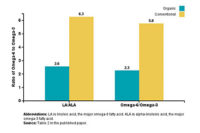Organic foods
Organic dairy is up 8% in 2013, but other organic foods, beverages grew more
The $4.9 billion dairy sector grew by 8%, and sales of organic beverages slowed to a 5% growth rate to around $4 billion.

Press release
WASHINGTON, D.C. (May 15, 2014) -- American consumers have not had their fill of organic products yet. In fact, sales of organic products in the United States jumped to $35.1 billion in 2013, up 11.5% from the previous year’s $31.5 billion and the fastest growth rate in five years, according to the latest survey on the organic industry from the Organic Trade Association (OTA).
And the hunger for organic products is not expected to ease any time soon. The OTA survey projects that growth rates over the next two years will at least keep pace with the 2013 clip and even slightly exceed it.
“The U.S. organic market is experiencing strong expansion, with organic food and farming continuing to gain in popularity. Consumers are making the correlation between what we eat and our health, and that knowledge is spurring heightened consumer interest in organic products,” said Laura Batcha, executive director and CEO of OTA.
OTA’s Organic Industry Survey is the most accurate and comprehensive quantitative picture of the organic industry available. It was conducted and produced by Nutrition Business Journal. Over 200 companies responded to the survey, which was conducted this year from January 27 through April 4. Companies gave data on revenues reported, sales growth, revenue by product and sales channel breakdowns.
Organic food sales in 2013, at $32.3 billion, accounted for roughly 92% of the total organic sales. Non-food organic products—including flowers, fiber, household products and pet food—are currently a very small part of the total organic market, but are making quick in-roads. Sales of non-food organic products, at almost $2.8 billion, have jumped nearly eight-fold since 2002, and have almost doubled in market share.
A niche industry in the huge food sector just a decade ago, consumer purchases of organic food first broke through the $30 billion mark in 2012 and now account for more than 4% of the $760 billion annual food sales in the United States. More telling, the growth rate of organic food sales, which has averaged almost 10% every year since 2010, has dwarfed the average annual growth of just over 3% in total food sales during that same period.
A product breakdown of the organic food sector shows that the fruit and vegetable category continues to lead the sector with $11.6 billion in sales, up 15%. With more than 10% of the fruits and vegetables sold in the United States now organic, the $1.5 billion in new sales of organic fruits and vegetable represented 46% of the organic sector’s $3.3 billion in new dollars.
The relatively small organic condiments category posted the strongest growth, at 17%, to reach sales of $830 million. Also showing double-digit growth were the organic snack food sector, up 15% to $1.7 billion; organic bread and grain sales up 12% to $3.8 billion; organic meat, poultry and fish sales up 11% to $675 million, and the rapidly expanding organic packaged and prepared food sector up 10% to $4.8 billion.
Just two categories of the organic food sector showed single-digit growth rates. The $4.9 billion dairy sector grew by 8%, and sales of organic beverages slowed to a 5% growth rate to around $4 billion.
But as demand for organic continues to boom and accessibility to organic products increases, the industry is facing some critical challenges.
Farmland in the United States is not being converted to organic at the pace needed to meet the growing demand for organic. Supplies of organic feed and organic grain have been tight and costly, which could limit growth especially in the organic dairy and meat sectors.
There is also lingering confusion among consumers about just what organic means. The message of the organic can be lost next to the presence of “natural” products and the long debate around GMOs.
“The entire organic industry needs to rally around helping consumers better understand and appreciate all the values that certified organic brings to the table,” said Batcha. “Consumer education is critical to grow the organic industry,” she added.
For information on how to purchase the full report, go to the Organic Trade Association bookstore.
Looking for a reprint of this article?
From high-res PDFs to custom plaques, order your copy today!








